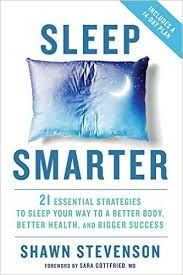 Even if you’re Vicki the Robot from Small Wonder, and you spend every night in a cabinet, you need this book. If you’re a human being, then you definitely need this book! I can’t possibly recommend it enough. Shawn Stevenson is hip, funny, and deeply knowledgeable about sleep. Even complicated charts and medical terminology are accessible through his engaging, witty prose. I’ve followed sleep research closely for at least the last decade, and I learned a great deal from Sleep Smarter. I can also validate a lot of the information as crucially important for healing sleep problems. Before I talk more about the book, I’ll share a bit about myself. I started having problems with insomnia at age seven. At fourteen, I woke up one morning and couldn’t open my mouth because I had clenched my jaw so tightly. I wound up cracking four mouth guards, and I wore through a set of amalgam fillings in eighteen months. I also had restless leg syndrome; sometimes it would start early in the evening, before I even went to bed. In college, the clinic sent me to the school psychiatrist to make sure I didn’t have a neurological problem, because I was only sleeping about three hours a night. Garden variety stuff. The real issue I had in my thirties was pavor nocturnus, or night terrors. I would wake up in a different room, shaking and crying, with no memory of how I got there. My poor husband would have to chase me and bring me back to bed. I don’t have sleep problems anymore. If someone like me can learn to sleep eight peaceful hours every night, then it stands to reason that anyone could. I’m also including a thumbnail of my sleep issues in case Shawn Stevenson reads this. If he does, HI! In the second edition, which you know is inevitable with a book this great, would you please consider including an appendix on insomnia and parasomnia disorders? Sleep Smarter includes short, fascinating chapters on sleep research. At the end, there is an easy set of micro-habits to try out over two weeks. It would be pretty easy to start with the chapter that seems most relevant; they don’t necessarily have to be read in order. For instance, anyone who has ever tried to share a “full” sized mattress with another person knows to start with the chapter on beds! If you’re reading this because you have annoying sleep issues, attend closely. Stevenson and I both make magnesium deficiency the first priority. If you can’t handle dietary change at this point in your life, you can buy a spray-on topical supplement. At least 80% of Americans are deficient in magnesium, so if you have any kind of sleep problem, be objective before you rule it out. For restless legs, talk to your doctor about an iron supplement. (Or you can keep a food log for three weeks, look at your micronutrient consumption, and make your own judgment). For tooth grinding, my dentist leveled out my bite by replacing my fillings. It changed my life. For pavor nocturnus, I discovered that it was related to blood sugar levels. I make sure not to eat for three hours before bedtime. I also became a marathon runner, and I believe that this changed my body’s ability to store glycogen in the muscles. This most likely helped my body to regulate blood sugar more efficiently, as I never get hangry anymore. I also quit getting migraines at the same time that I quit having the night terrors, which is now over two years ago. I took melatonin for five years, and it helped me learn to sleep properly. About three weeks ago, I quit taking it, and was astonished to find that my sleep is the same quality and duration! I was very worried about experiencing sleepless nights, but it didn’t happen once. To me, this is verification that all the other changes I made really did have an impact. For everything, I quadrupled my cruciferous vegetable consumption. What Stevenson has to say about nutrition and fitness is completely true. I was also extremely interested in his personal story about battling degenerative disk disease as a teenager. He asked his doctor if his diagnosis “had anything to do with what [he] was eating, or if exercising a different way would help.” His doctor completely blew him off. That was precisely my experience with talking to my physician about my thyroid disease when I was 23. Stevenson’s disk disease had nothing in common with my thyroid disease, but the bogus, unscientific professional opinions we got were the same. I believe in medical science, but I seriously question whether doctors are keeping up with the most current research before they convey life-changing opinions to people. That’s before we even begin to consider nutrition and exercise, which few doctors seem to take seriously on a personal level, much less a professional one. Please read this book. Please take the quality and quantity of your sleep seriously. Please believe that improving your sleep truly does have the potential to revolutionize your life. Oh, and PS: Noelie says that if you have a pet parrot or other bird, please make sure it gets twelve hours of sleep in a dark, quiet room every night. Comments are closed.
|
AuthorI've been working with chronic disorganization, squalor, and hoarding for over 20 years. I'm also a marathon runner who was diagnosed with fibromyalgia and thyroid disease 17 years ago. This website uses marketing and tracking technologies. Opting out of this will opt you out of all cookies, except for those needed to run the website. Note that some products may not work as well without tracking cookies. Opt Out of CookiesArchives
January 2022
Categories
All
|
 RSS Feed
RSS Feed